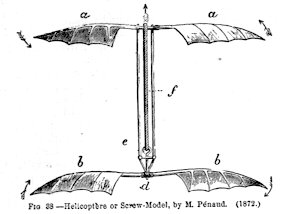Helicopter
Today, we invent the helicopter. The University of Houston's College of Engineering presents this series about the machines that make our civilization run, and the people whose ingenuity created them.
Throughout the 19th century we tried to fly. We had a highly-honed technology of lighter-than-air flight before the Wright Brothers. We'd also spent vast human energy on two kinds of heavier-than-air flight: flapping-wing machines and helicopters. We never did master flapping wings, but helicopters were another story.
Heavier-than-air flight takes three forms: Airplanes lift off the ground when a propeller or jet pulls a lifting wing through the air. A powered propeller also pulls an autogyro forward; but instead of a wing it has a large freewheeling propeller on top. But in a helicopter, the propeller on top is powered. It lifts the machine directly upward, combining power and lift in the same place.
Five centuries ago, Leonardo da Vinci suggested the seductively simple idea that we might pull ourselves into the air with a vertically mounted propeller. The idea resurfaced in 18th-century France. The same year the first balloon went up, a model helicopter, driven by a bowstring, appeared. During the 19th century, all kinds of ingenious helicopter models were built in Europe.
 Around 1872 a young French experimenter, Alphonse Penaud, managed to stabilize a rubber-band-powered toy helicopter. He used counter-rotating propellers at either end of a vertical shaft, one above, the other below. Bishop Milton Wright brought a Penaud-type helicopter model home to his boys Orville and Wilbur, and the rest is history.
Around 1872 a young French experimenter, Alphonse Penaud, managed to stabilize a rubber-band-powered toy helicopter. He used counter-rotating propellers at either end of a vertical shaft, one above, the other below. Bishop Milton Wright brought a Penaud-type helicopter model home to his boys Orville and Wilbur, and the rest is history.
So attempts to build helicopters escalated. Three years after Penaud made his model helicopter, Enrico Forlanini flew a steam-powered helicopter forty feet into the air in Italy. In 1907 Paul Cornu hovered just off the ground for twenty seconds in his delicate double-propeller helicopter. Cornu, like the Wright Brothers, was a bicycle maker.
Other helicopters were built, but they were all hard to control. Then the autogyro appeared, and attention drifted away from helicopters. But Igor Sikorsky, who'd tried to build one in Tzarist Russia, finally tried again with vastly improved technology in America. He succeeded in 1939.
The late '30s actually produced a spate of European attempts to build helicopters or, in some cases, autogyros with engine-driven upper propellers. But Sikorsky built the first pure helicopter that actually performed well. The Germans soon followed. The Russians copied the Germans. And we all had military helicopters in the late years of WW-II.
Helicopters were in people's minds long before airplanes. But the very simplicity of combining power and lift in one big propeller led to terrible design problems. Leonardo, drawn in by its simplicity, couldn't see how hard it would be to control motion with a single propeller. Complexity, masking as simplicity, teased designers for centuries. Lucky for us, it kept right on teasing them even after we had DC-3s, Spitfires, and Piper Cubs.
I'm John Lienhard, at the University of Houston, where we're interested in the way inventive minds work.
(Theme music)
Angelucci, E., World Encyclopedia of Civil Aircraft. New York: Crown Publishers, Inc., 1982, Chapter 1.
Morris, C. L., Pioneering the Helicopter. New York: McGraw-Hill Book Company, 1945.
This is a greatly revised version of Episode 85.

From The Art of Flying, 1911

An Autogyro, the Hybrid Airplane/Helicopter